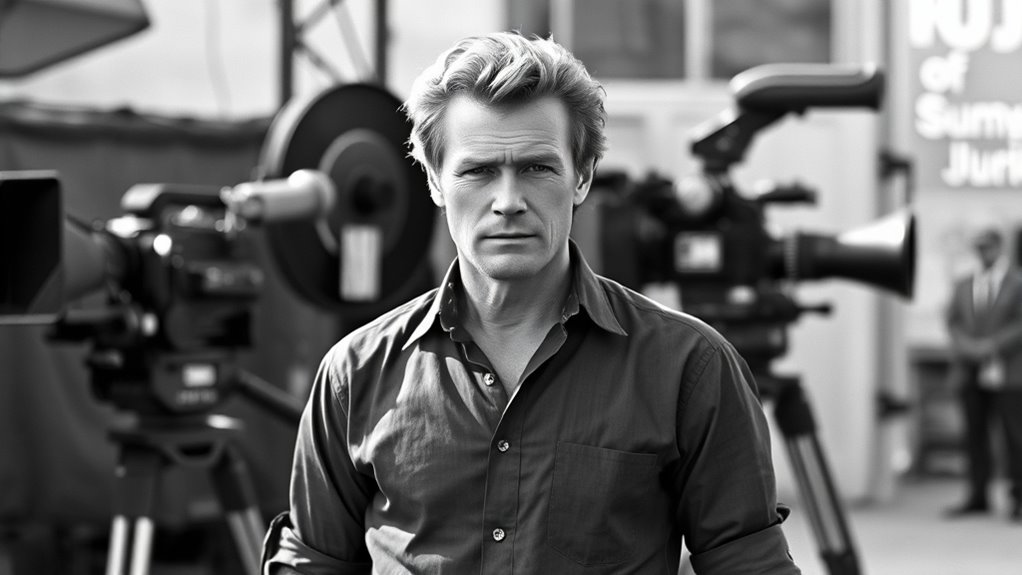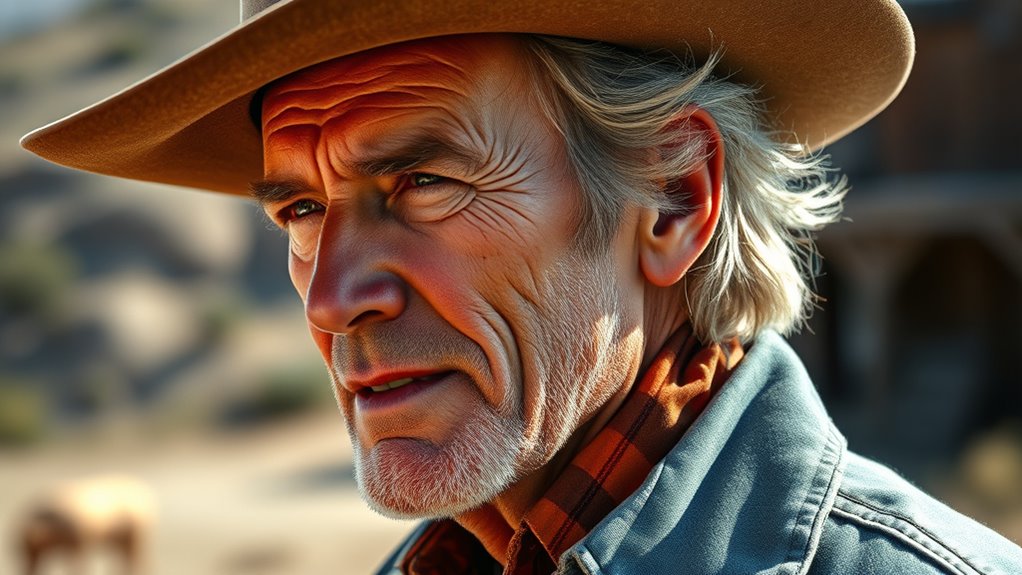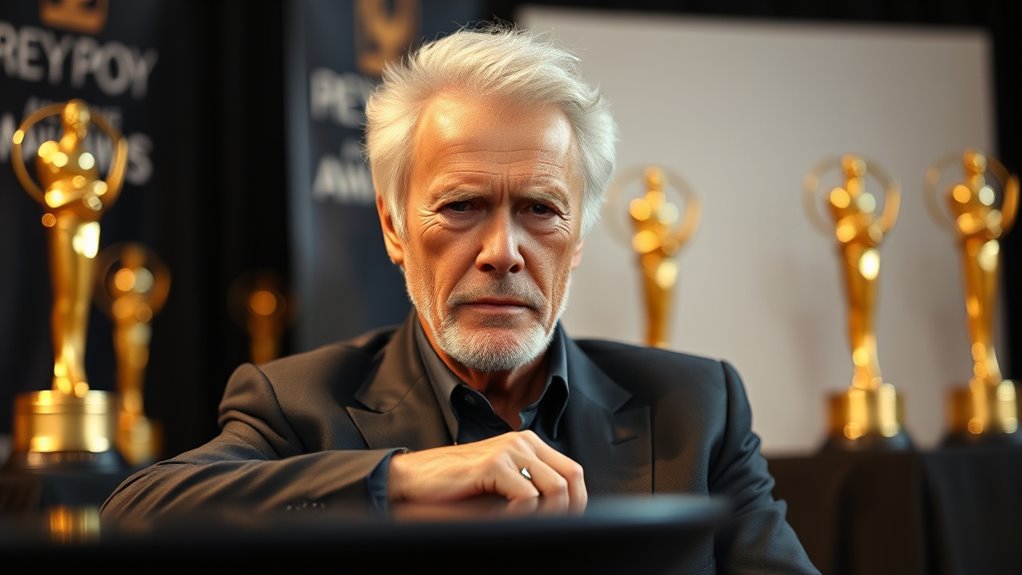Clint Eastwood is a legendary actor and director whose career spans over 60 years. You might recognize him for iconic roles like the Man with No Name and Harry Callahan, which redefined Hollywood archetypes. As a director, he’s known for gritty films like *Unforgiven* and *Million Dollar Baby*, winning multiple awards. His influence extends beyond acting and directing, shaping American cinema and culture. If you keep exploring, you’ll discover how his work continues to inspire many.
Key Takeaways
- Renowned for iconic roles in Westerns and gritty cop films, establishing archetypes like the Man with No Name and Dirty Harry.
- Pioneered filmmaking with acclaimed directorial works such as *Unforgiven* and *Million Dollar Baby*.
- Awarded four Academy Awards, four Golden Globes, and numerous international honors for his acting and directing.
- Influenced global cinema with a distinctive visual style and morally complex storytelling.
- Recognized as a cinematic icon for shaping Hollywood’s portrayal of heroism, morality, and social issues.
Early Beginnings and Rise to Stardom

Clint Eastwood’s journey to stardom began with humble roots and a diverse background. Born in San Francisco on May 31, 1930, you come from a family with mixed English, Irish, Scottish, and Dutch ancestry, descended from Mayflower passenger William Bradford. Raised in an affluent Piedmont neighborhood, you enjoyed a comfortable childhood, with family moving often during the Great Depression. You graduated from Oakland Technical High School in 1949 and briefly studied business at Los Angeles City College before dropping out to pursue acting. During your youth, you cultivated interests in music, mechanics, and worked various jobs like lifeguarding and pool digging. Your early exposure to cinema, combined with military service at Fort Ord, laid the groundwork for your eventual entry into Hollywood. He served two years at Fort Ord Military Reservation, which strengthened your discipline and work ethic. Additionally, your military experience contributed to your work ethic and discipline, which became essential in your acting career.
Iconic Roles and Acting Evolution

How did Clint Eastwood’s roles evolve from gritty Western antiheroes to complex, emotionally layered characters? You see, he started with iconic Western roles like the Man with No Name in Sergio Leone’s spaghetti westerns, establishing a tough, laconic archetype. As his career progressed, he played characters like Josey Wales and William Munny, adding emotional depth and moral complexity. Eastwood’s tough, lone wolf characters, such as Harry Callahan and Walt Kowalski, reflected his gritty persona but grew more nuanced over time. His later roles, like Frankie Dunn and Robert Kincaid, showed vulnerability and tenderness, revealing his range beyond action. This evolution allowed him to portray conflicted lawmen, mentors, and aging protagonists, demonstrating his mastery in balancing stoicism with emotional authenticity. Throughout his career, he has consistently demonstrated an ability to adapt his performances to embody a wide spectrum of human experience, including acting versatility that has set him apart in Hollywood.
Pioneering Films as a Director

Eastwood’s early films as a director laid a foundation that would define his distinctive style. You see, his debut with *Play Misty for Me* (1971) introduced tense, character-driven storytelling. He then experimented with genre blending in *High Plains Drifter* (1973), mixing suspense and supernatural elements, and solidified his Western mastery with *The Outlaw Josey Wales* (1976). His gritty, minimalist approach became clear through films like *The Gauntlet* and *Sudden Impact*. His films from this period often received high praise, with *Unforgiven* (1992) earning an 8.2 rating, exemplifying his ability to craft complex antiheroes and morally ambiguous stories. You’ll feel the impact of his themes:
Eastwood’s early films showcase tense storytelling, genre blending, and gritty Western mastery that define his distinctive style.
- Strong antiheroes grappling with moral ambiguity
- Visually stark landscapes echoing inner conflicts
- Stories balancing violence with redemption
These pioneering works set the stage for his later acclaimed films, showcasing his unique ability to blend genre, emotion, and depth in each directorial effort. Additionally, his distinctive visual style often employs stark contrast and simplicity, emphasizing the themes and characters within his stories.
Awards, Honors, and Industry Impact

| Award Type | Notable Achievements |
|---|---|
| Academy Awards | 4 wins, multiple nominations |
| Golden Globes | 4 wins, numerous categories |
| International Honors | Legion of Honour, Golden Lion |
| Industry Recognition | Over 160 wins, cross-cultural influence |
| Industry Impact | Recognized for his influence on International Finance and cinematic storytelling |
Lasting Legacy and Cultural Significance
Clint Eastwood’s enduring legacy and cultural significance are evident in his ability to shape American cinema and influence societal perceptions of heroism and morality. Throughout a career spanning over six decades, you see his adaptability, from Westerns to drama and action, maintaining relevance and respect. His iconic roles, like the Man with No Name and Dirty Harry, have defined archetypes and reflected shifting masculinity themes, sparking conversations on justice and redemption. His influence extends beyond film, reshaping the Western genre, inspiring filmmakers, and addressing social issues through his stories. You can feel his impact in how he balances artistic integrity with commercial success, leaving a mark on American culture. His prolific career has also included mentoring many emerging artists and promoting new storytelling techniques that continue to influence the industry today. Additionally, his work has been recognized with numerous awards and honors, solidifying his status as a cinematic icon and a pioneer in the industry. – Inspires generations with complex characters and themes – Redefined notions of heroism and morality – Continues to influence society and cinema today
Frequently Asked Questions
What Inspired Clint Eastwood’s Transition From Acting to Directing?
You’re curious about what inspired the shift from acting to directing. You learn that Eastwood wanted more artistic control and was frustrated with repetitive roles. Influenced by mentors like Don Siegel, he saw directing as a way to tell deeper stories. Conversations with trusted collaborators and a desire to avoid typecasting motivated him to pursue directing, allowing for greater creative expression and longevity in the film industry.
How Does Clint Eastwood Choose Projects for His Films?
You notice that he chooses projects based on personal experience and artistic growth, preferring stories that reflect his life and filmmaking journey. He looks for roles that let him revisit themes like masculinity and heroism, often involving control over the entire process. He favors complex, controversial subjects with moral depth, aligning with his worldview. His selections balance artistic challenge, commercial potential, and opportunities to work with trusted collaborators, even as he ages.
What Are Clint Eastwood’s Influences From Other Filmmakers?
Think of Eastwood’s influences as a tapestry woven from many threads. You see classic directors like John Ford and Howard Hawks shaping his storytelling and character focus. Sergio Leone’s gritty European Westerns added darker themes and innovative visuals. Collaborations with Don Siegel and Spielberg further refined his style. These influences blend into a unique voice, allowing Eastwood to craft films that explore morality, justice, and solitude with a timeless, human touch.
How Has Clint Eastwood’s Personal Life Influenced His Filmmaking?
You can see how his personal life shapes his filmmaking—his upbringing during the Great Depression fosters themes of resilience, while his complex relationships add depth to portrayals of flawed characters. His experiences with loss, betrayal, and family struggles bring emotional authenticity to his stories. You notice a focus on redemption, internal conflict, and outsider characters, reflecting his own life challenges and the need for forgiveness and understanding in his films.
What Is Clint Eastwood’s Approach to Mentoring New Talent?
They say, “A teacher affects eternity,” and you can see that in Eastwood’s mentoring style. You’re encouraged to trust your instincts and take ownership of your work. He provides guidance with patience, giving actors and new directors the freedom to explore their craft. His supportive yet confident approach builds confidence, fosters independence, and creates a collaborative environment, ultimately helping emerging talent grow and succeed in their filmmaking journeys.
Conclusion
You can’t deny that Clint Eastwood’s influence is nothing short of legendary—his career is a titan in Hollywood history. From gritty actor to visionary director, he’s shaped the industry in ways that will echo for generations. His films aren’t just movies; they’re masterpieces that redefine storytelling. As you reflect on his incredible journey, one thing’s clear: Clint Eastwood isn’t just a star, he’s an unstoppable force that continues to shine brighter than ever.









